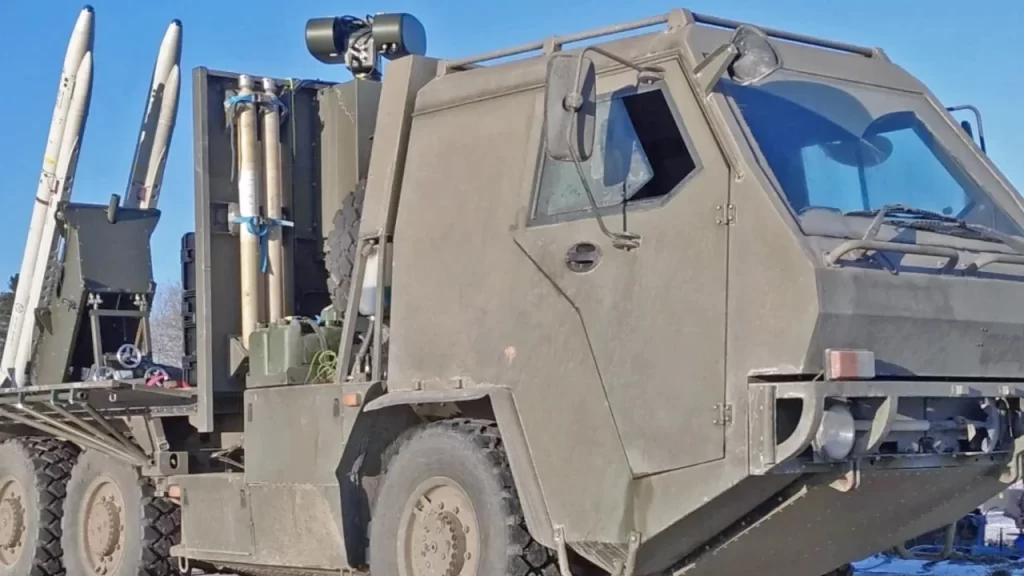A photograph of a British SupaCat vehicle carrying AIM-132 ASRAAM (Advanced Short-Range Air-to-Air Missile) anti-aircraft missiles was released by the Ukrainian Army. This is a makeshift solution to the Ukrainian military’s most pressing problem: the scarcity of ground-to-air missiles for air defence.
The British newspaper “The Times” reports that the United Kingdom has supplied Ukraine’s armed forces with “several” launcher units of a semi-improvised anti-aircraft missile system based on the use of AIM-132 ASRAAM class “air-to-air” short-range missiles with an infrared guidance system adapted for anti-aircraft use. These missiles’ are hosted on a self-propelled launcher based on the British military vehicle Supacat HMT (6×6).
The primary purpose of these anti-aircraft missile systems is to counter barrage-type munitions such as the UAV “Shahed and its derivatives,” but some of the complexes are also used for regular air defence tasks. It is stated that ASRAAM missiles can be launched beyond the direct line of sight and can track targets after launch, with target guidance potentially transmitted via radio communication to the missile after launch.
Based on the provided image of the launcher unit, it appears equipped with an optically-electronic detection station behind the cabin, likely on a raised mast. Long-range detection of airborne targets appears to be managed by an external radar system, probably another truck or a pickup.
The British Royal Air Force adopted the AIM-132 ASRAAM in 1998. MBDA UK, the British unit of the European consortium MBDA, developed and manufactured it. Additionally, the missile has been delivered to the air forces of Australia, India, Qatar, and Oman. The United States initially intended to use the missile as well. As a result, it was given the designation AIM-132 by the United States, but in 1996 the US Department of Defence decided to acquire the modified Sidewinder AIM-9X missile instead.
The ASRAAM missile weighs 88 kilogrammes and has a 10-kilogram warhead. It measures 2,9 metres in length, has a body diameter of 166 mm, and a wing extent of 455 mm. The official range of the “air-to-air” variant of the ASRAAM missile is described as “over 15 miles” (or more than 25 kilometres), but unofficial reports imply it can reach up to 50 kilometres. If this information is accurate, the missile’s range as an anti-aircraft system, when launched from a launcher on the ground, could reach 15 to 20 kilometres.

Due to the retirement of F/A-18A/B Hornet fighter aircraft, a significant surplus of ASRAAM missiles became available in the Royal Australian Air Force. Current Australian fighter aircraft, F/A-18F, EA-18G, and F-35A, are equipped with AIM-9X missiles, so Australian ASRAAM missiles, of which 400 were purchased under a 1998 contract and at least 20 more were acquired from the United Kingdom in 2011, could potentially be sent to Ukraine.
The high consumption of ground-to-air missiles is a significant obstacle for Ukrainian air defence. Russia employs Shahed-type drones to overwhelm the Ukrainian air defence, forcing the Ukrainians to resort to expensive ground-to-air missiles. Each destroyed Shahed drone accomplishes its mission. For the Russians, destroying a Shahed drone is preferable to having it strike an unjustified urban area. In addition, the Russians seem to have an almost inexhaustible supply of these rudimentary Shahed drones.
Current stocks of surface-to-air missiles for Patriot systems, European systems such as IRIS-T, NASAMS, Crotale, and Ukrainian S-300 systems are diminishing. In the foreseeable future, neither the American nor the European armaments industries will be able to produce enough specialised short- to medium-range ground-to-air missiles to supply the Ukrainian air defence sustainably.
In light of this, the British-developed ASRAAM air-to-air missile costs approximately £200,000, and a limited number of modified SupaCat launch vehicles becomes a practical alternative for Ukraine. The SupaCat carries launch apparatus for two ASRAAM missiles on its bed. Vertical storage space for spare ASRAAM “missiles” is in the front.
The ASRAAM has an infrared seeker with a 90° field of view and 128×128 pixel resolution. This enables it to filter flares and identify the impact location. During flight, the missile is guided towards its objective by inertial navigation. The missile can achieve Mach 3 velocity and withstand up to 50 Gs of acceleration. The fragmentation warhead has both contact and proximity fuzes.
Even when launched from a SupaCat, the ASRAAM can function in one of two ways: either the missile’s sensor head acquires and latches onto the target before launch, or the missile is fired to a general target area, and then its infrared seeker begins functioning – Lock-On After Launch.
The original version of the missile lacks a datalink, preventing it from obtaining real-time information regarding the target’s position during flight. Components of ASRAAM are incorporated into the CAMM (Common Anti-Air Modular Missile) surface-to-air missile of the Sky Sabre air defence system. CAMM possesses a datalink.
The SupaCat launch vehicle reportedly features a sensor mounted on a retractable mast, possibly from Leonardo. This sensor is used for acquiring and tracking targets. The vehicle can be regarded as a “firing unit” capable of engaging aerial targets independently; it is equipped with fire control systems, sensors, and effectors. The SupaCat incorporates communication and fire control systems, allowing it to receive autonomously and process data from external sensors (radars) or command structures. The 6×6 wheeled SupaCat platform is an extremely mobile, compact vehicle with excellent off-road capability. This enables it to operate near the front lines while remaining effectively concealed.
